MGN433 Assignment: Analyzing High Performance Organizations Case Study
VerifiedAdded on 2023/01/10
|11
|2813
|47
Case Study
AI Summary
This assignment is a case study analysis of PepsiCo, examining it through the lens of a high-performance organization (HPO). The paper begins by defining HPOs and outlining both internal factors, such as human resources, leadership, and organizational culture, and external factors, including technology, customers, and resources, that shape their performance. It then details a set of key criteria for assessing HPOs, encompassing commitment to excellence, clearly stated purpose, effective change management, open communication, continuous learning culture, talent management, strong leadership, and empowerment. The core of the assignment applies these criteria to PepsiCo, demonstrating how the company aligns with HPO principles through its commitment to excellence, clearly defined objectives, change management processes, communication strategies, learning culture, talent management, strong leadership, and employee empowerment initiatives. The analysis highlights PepsiCo's sustainable practices, innovation, and commitment to stakeholder value, concluding with an evaluation of PepsiCo's strengths and areas for improvement, solidifying its position as a leading global organization. The analysis references multiple academic sources to support its findings.
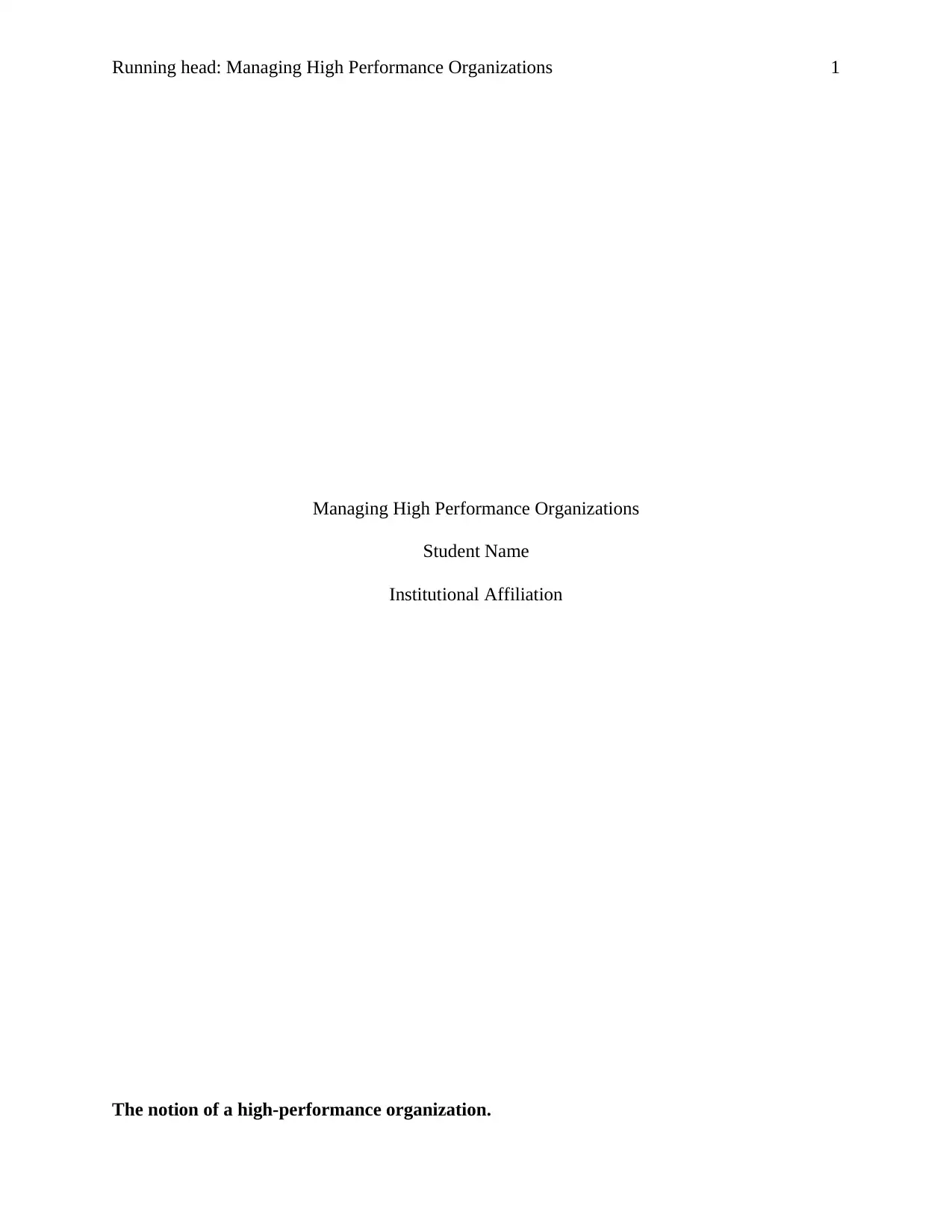
Running head: Managing High Performance Organizations 1
Managing High Performance Organizations
Student Name
Institutional Affiliation
The notion of a high-performance organization.
Managing High Performance Organizations
Student Name
Institutional Affiliation
The notion of a high-performance organization.
Paraphrase This Document
Need a fresh take? Get an instant paraphrase of this document with our AI Paraphraser
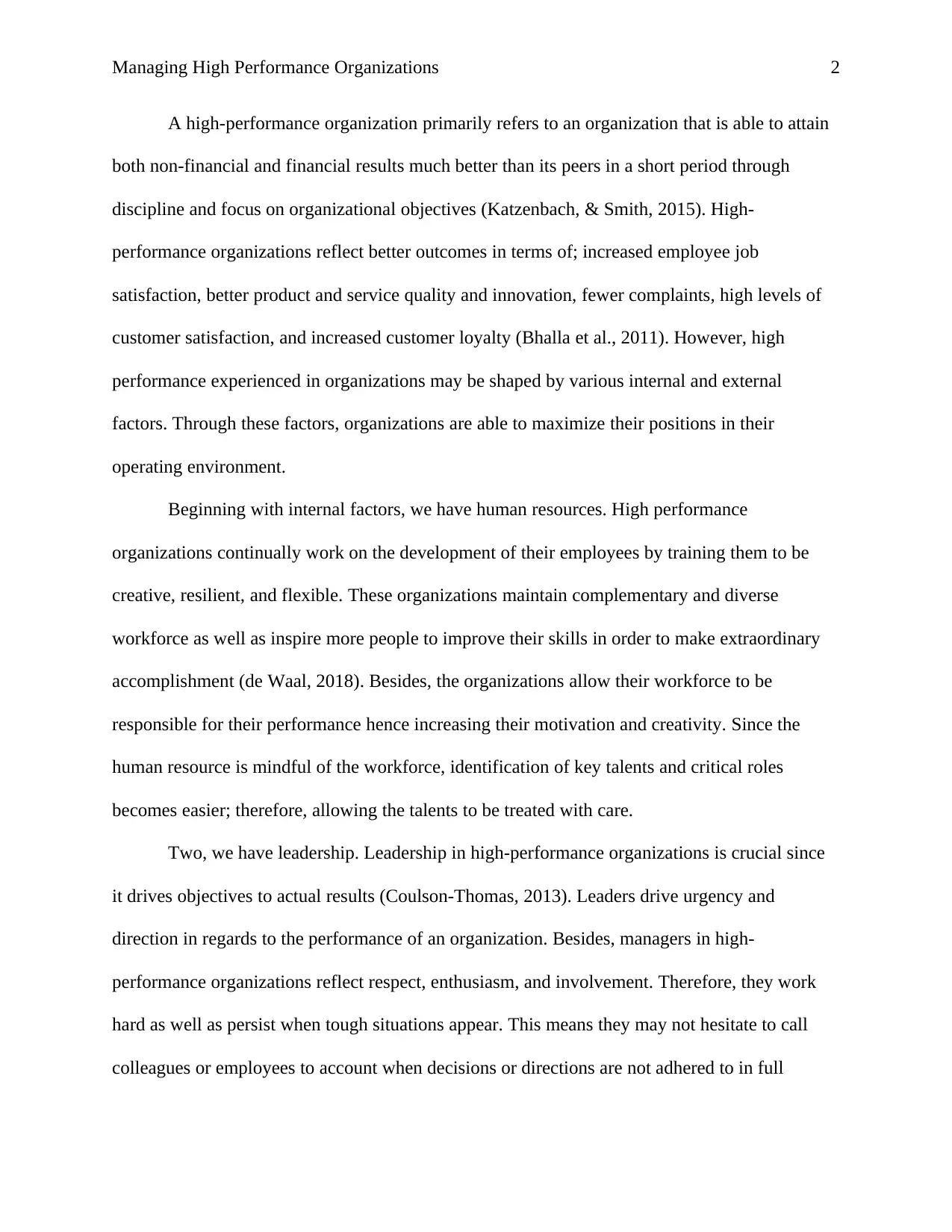
Managing High Performance Organizations 2
A high-performance organization primarily refers to an organization that is able to attain
both non-financial and financial results much better than its peers in a short period through
discipline and focus on organizational objectives (Katzenbach, & Smith, 2015). High-
performance organizations reflect better outcomes in terms of; increased employee job
satisfaction, better product and service quality and innovation, fewer complaints, high levels of
customer satisfaction, and increased customer loyalty (Bhalla et al., 2011). However, high
performance experienced in organizations may be shaped by various internal and external
factors. Through these factors, organizations are able to maximize their positions in their
operating environment.
Beginning with internal factors, we have human resources. High performance
organizations continually work on the development of their employees by training them to be
creative, resilient, and flexible. These organizations maintain complementary and diverse
workforce as well as inspire more people to improve their skills in order to make extraordinary
accomplishment (de Waal, 2018). Besides, the organizations allow their workforce to be
responsible for their performance hence increasing their motivation and creativity. Since the
human resource is mindful of the workforce, identification of key talents and critical roles
becomes easier; therefore, allowing the talents to be treated with care.
Two, we have leadership. Leadership in high-performance organizations is crucial since
it drives objectives to actual results (Coulson-Thomas, 2013). Leaders drive urgency and
direction in regards to the performance of an organization. Besides, managers in high-
performance organizations reflect respect, enthusiasm, and involvement. Therefore, they work
hard as well as persist when tough situations appear. This means they may not hesitate to call
colleagues or employees to account when decisions or directions are not adhered to in full
A high-performance organization primarily refers to an organization that is able to attain
both non-financial and financial results much better than its peers in a short period through
discipline and focus on organizational objectives (Katzenbach, & Smith, 2015). High-
performance organizations reflect better outcomes in terms of; increased employee job
satisfaction, better product and service quality and innovation, fewer complaints, high levels of
customer satisfaction, and increased customer loyalty (Bhalla et al., 2011). However, high
performance experienced in organizations may be shaped by various internal and external
factors. Through these factors, organizations are able to maximize their positions in their
operating environment.
Beginning with internal factors, we have human resources. High performance
organizations continually work on the development of their employees by training them to be
creative, resilient, and flexible. These organizations maintain complementary and diverse
workforce as well as inspire more people to improve their skills in order to make extraordinary
accomplishment (de Waal, 2018). Besides, the organizations allow their workforce to be
responsible for their performance hence increasing their motivation and creativity. Since the
human resource is mindful of the workforce, identification of key talents and critical roles
becomes easier; therefore, allowing the talents to be treated with care.
Two, we have leadership. Leadership in high-performance organizations is crucial since
it drives objectives to actual results (Coulson-Thomas, 2013). Leaders drive urgency and
direction in regards to the performance of an organization. Besides, managers in high-
performance organizations reflect respect, enthusiasm, and involvement. Therefore, they work
hard as well as persist when tough situations appear. This means they may not hesitate to call
colleagues or employees to account when decisions or directions are not adhered to in full

Managing High Performance Organizations 3
measure. In high-performance organizations, leadership is through networks of well-trained
employees that have the resources to make and execute decisions (Gleeson, 2017). By achieving
this, the organizations are able to create a more nimble and agile cultural environment that allow
decisions to made quicker and better.
Three, we have organizational culture. High-performance organizations design their
organizational culture in ways that promote constant learning so as to ensure the workforce can
build their skills much easily and quickly. Having a robust performance cultures ensure the
organizations think innovatively hence being able to find effective ways of doing things (Sayle,
2016). Also, the high-performance culture cultivates enthusiasm and engagement which allows
organizations to take chances in risk environments. This helps foster learning and independent
thinking.
On the other hand, we have external factors. To begin with, we have technology and
innovation. Technology has become a crucial tool in controlling performance in organizations.
High-performance organizations are constantly trying to improve customer service through
innovation (Bello-Pintado, García Marco & Zouaghi, 2019). These organizations are more driven
to meet the changing market demands but as well be able to anticipate the demands. Therefore,
the organizations can choose to innovate products, services and processes hence being able to
create new sources of competitive advantage that increase the rate of response to market
demands and changes. In addition, through innovation, high-performance organizations master
core competencies that allow them to be the best in what they do inside the firm and outside the
firm (HPO Center, 2019).
Two, we have customers. Customers are an essential part of high-performance
organizations. These organizations understand how to evaluate the interest and needs of
measure. In high-performance organizations, leadership is through networks of well-trained
employees that have the resources to make and execute decisions (Gleeson, 2017). By achieving
this, the organizations are able to create a more nimble and agile cultural environment that allow
decisions to made quicker and better.
Three, we have organizational culture. High-performance organizations design their
organizational culture in ways that promote constant learning so as to ensure the workforce can
build their skills much easily and quickly. Having a robust performance cultures ensure the
organizations think innovatively hence being able to find effective ways of doing things (Sayle,
2016). Also, the high-performance culture cultivates enthusiasm and engagement which allows
organizations to take chances in risk environments. This helps foster learning and independent
thinking.
On the other hand, we have external factors. To begin with, we have technology and
innovation. Technology has become a crucial tool in controlling performance in organizations.
High-performance organizations are constantly trying to improve customer service through
innovation (Bello-Pintado, García Marco & Zouaghi, 2019). These organizations are more driven
to meet the changing market demands but as well be able to anticipate the demands. Therefore,
the organizations can choose to innovate products, services and processes hence being able to
create new sources of competitive advantage that increase the rate of response to market
demands and changes. In addition, through innovation, high-performance organizations master
core competencies that allow them to be the best in what they do inside the firm and outside the
firm (HPO Center, 2019).
Two, we have customers. Customers are an essential part of high-performance
organizations. These organizations understand how to evaluate the interest and needs of
⊘ This is a preview!⊘
Do you want full access?
Subscribe today to unlock all pages.

Trusted by 1+ million students worldwide
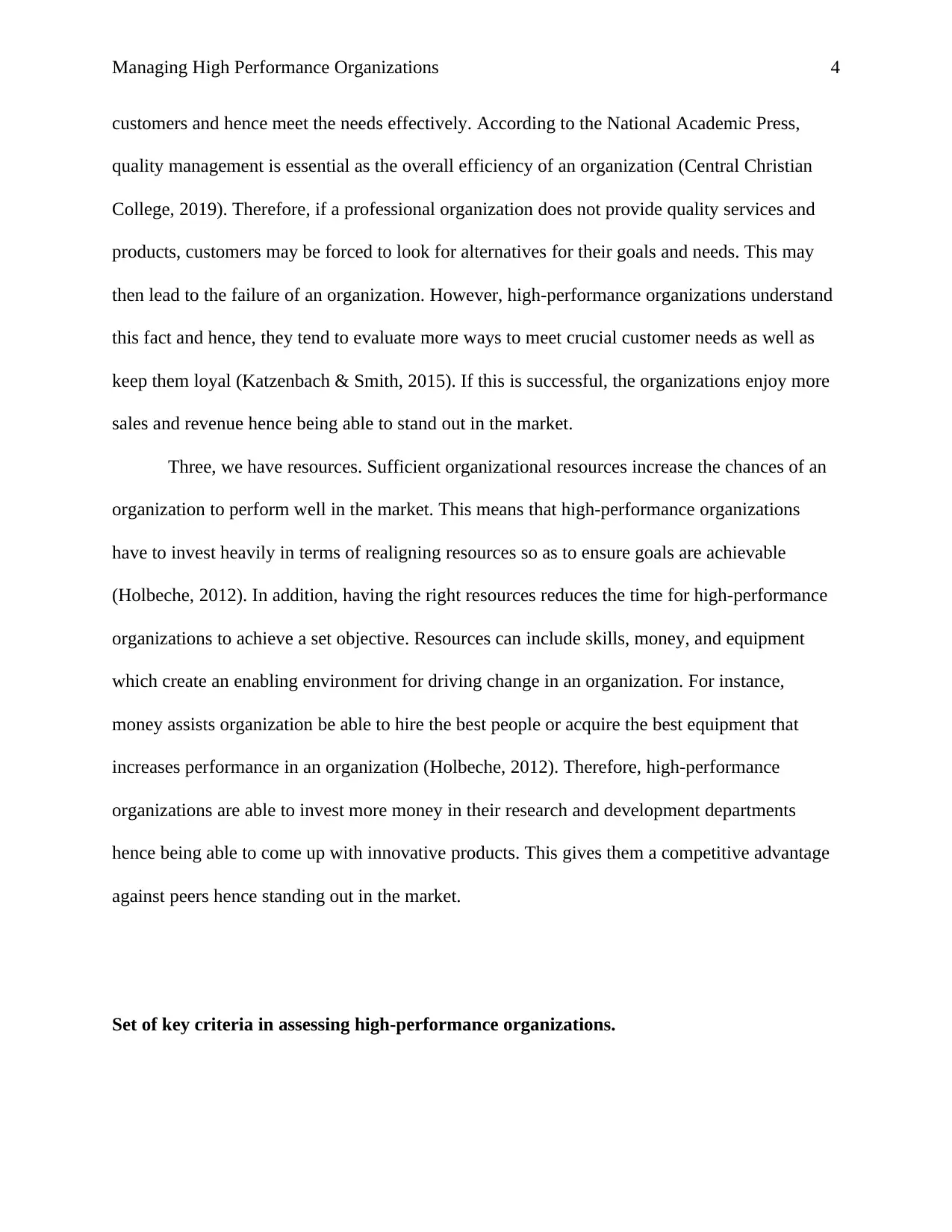
Managing High Performance Organizations 4
customers and hence meet the needs effectively. According to the National Academic Press,
quality management is essential as the overall efficiency of an organization (Central Christian
College, 2019). Therefore, if a professional organization does not provide quality services and
products, customers may be forced to look for alternatives for their goals and needs. This may
then lead to the failure of an organization. However, high-performance organizations understand
this fact and hence, they tend to evaluate more ways to meet crucial customer needs as well as
keep them loyal (Katzenbach & Smith, 2015). If this is successful, the organizations enjoy more
sales and revenue hence being able to stand out in the market.
Three, we have resources. Sufficient organizational resources increase the chances of an
organization to perform well in the market. This means that high-performance organizations
have to invest heavily in terms of realigning resources so as to ensure goals are achievable
(Holbeche, 2012). In addition, having the right resources reduces the time for high-performance
organizations to achieve a set objective. Resources can include skills, money, and equipment
which create an enabling environment for driving change in an organization. For instance,
money assists organization be able to hire the best people or acquire the best equipment that
increases performance in an organization (Holbeche, 2012). Therefore, high-performance
organizations are able to invest more money in their research and development departments
hence being able to come up with innovative products. This gives them a competitive advantage
against peers hence standing out in the market.
Set of key criteria in assessing high-performance organizations.
customers and hence meet the needs effectively. According to the National Academic Press,
quality management is essential as the overall efficiency of an organization (Central Christian
College, 2019). Therefore, if a professional organization does not provide quality services and
products, customers may be forced to look for alternatives for their goals and needs. This may
then lead to the failure of an organization. However, high-performance organizations understand
this fact and hence, they tend to evaluate more ways to meet crucial customer needs as well as
keep them loyal (Katzenbach & Smith, 2015). If this is successful, the organizations enjoy more
sales and revenue hence being able to stand out in the market.
Three, we have resources. Sufficient organizational resources increase the chances of an
organization to perform well in the market. This means that high-performance organizations
have to invest heavily in terms of realigning resources so as to ensure goals are achievable
(Holbeche, 2012). In addition, having the right resources reduces the time for high-performance
organizations to achieve a set objective. Resources can include skills, money, and equipment
which create an enabling environment for driving change in an organization. For instance,
money assists organization be able to hire the best people or acquire the best equipment that
increases performance in an organization (Holbeche, 2012). Therefore, high-performance
organizations are able to invest more money in their research and development departments
hence being able to come up with innovative products. This gives them a competitive advantage
against peers hence standing out in the market.
Set of key criteria in assessing high-performance organizations.
Paraphrase This Document
Need a fresh take? Get an instant paraphrase of this document with our AI Paraphraser
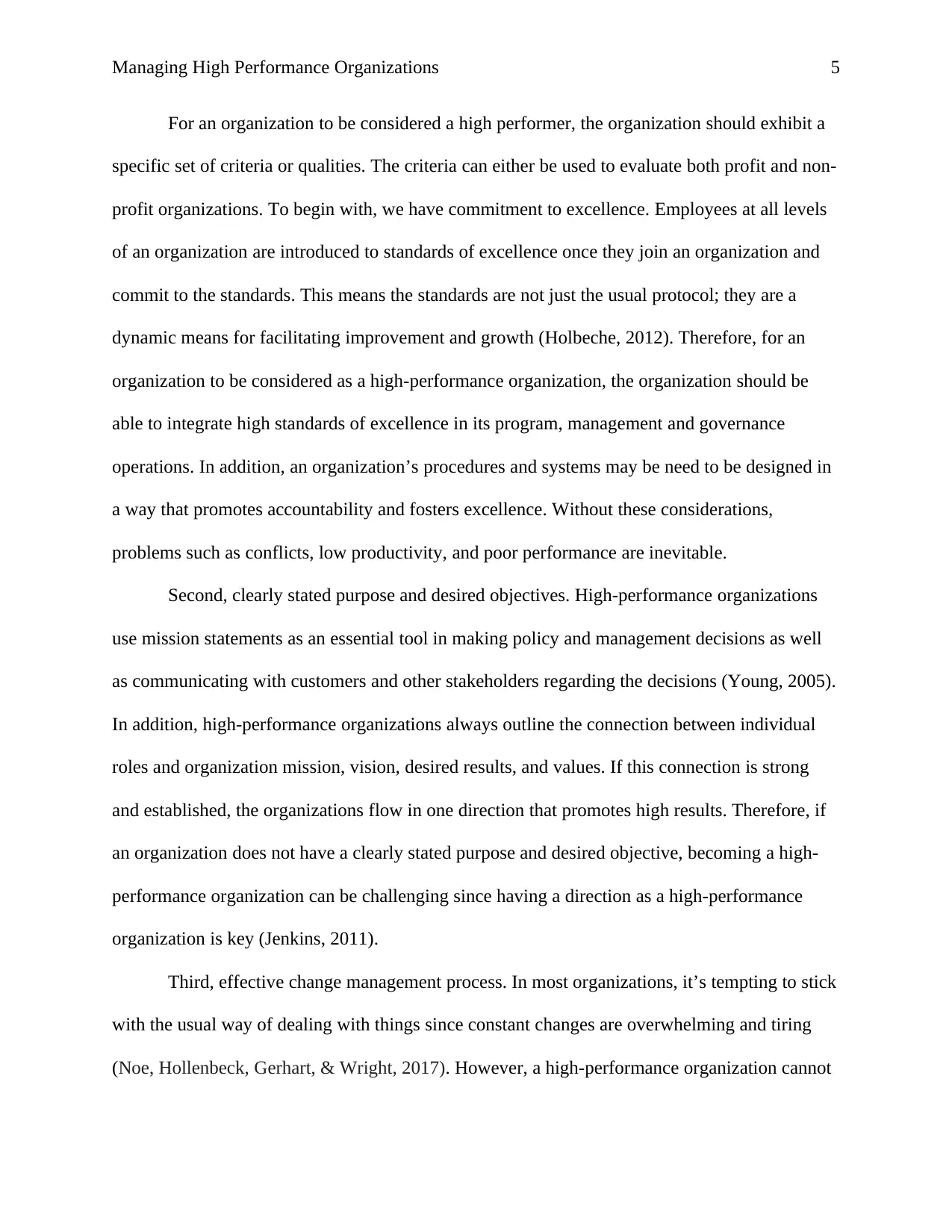
Managing High Performance Organizations 5
For an organization to be considered a high performer, the organization should exhibit a
specific set of criteria or qualities. The criteria can either be used to evaluate both profit and non-
profit organizations. To begin with, we have commitment to excellence. Employees at all levels
of an organization are introduced to standards of excellence once they join an organization and
commit to the standards. This means the standards are not just the usual protocol; they are a
dynamic means for facilitating improvement and growth (Holbeche, 2012). Therefore, for an
organization to be considered as a high-performance organization, the organization should be
able to integrate high standards of excellence in its program, management and governance
operations. In addition, an organization’s procedures and systems may be need to be designed in
a way that promotes accountability and fosters excellence. Without these considerations,
problems such as conflicts, low productivity, and poor performance are inevitable.
Second, clearly stated purpose and desired objectives. High-performance organizations
use mission statements as an essential tool in making policy and management decisions as well
as communicating with customers and other stakeholders regarding the decisions (Young, 2005).
In addition, high-performance organizations always outline the connection between individual
roles and organization mission, vision, desired results, and values. If this connection is strong
and established, the organizations flow in one direction that promotes high results. Therefore, if
an organization does not have a clearly stated purpose and desired objective, becoming a high-
performance organization can be challenging since having a direction as a high-performance
organization is key (Jenkins, 2011).
Third, effective change management process. In most organizations, it’s tempting to stick
with the usual way of dealing with things since constant changes are overwhelming and tiring
(Noe, Hollenbeck, Gerhart, & Wright, 2017). However, a high-performance organization cannot
For an organization to be considered a high performer, the organization should exhibit a
specific set of criteria or qualities. The criteria can either be used to evaluate both profit and non-
profit organizations. To begin with, we have commitment to excellence. Employees at all levels
of an organization are introduced to standards of excellence once they join an organization and
commit to the standards. This means the standards are not just the usual protocol; they are a
dynamic means for facilitating improvement and growth (Holbeche, 2012). Therefore, for an
organization to be considered as a high-performance organization, the organization should be
able to integrate high standards of excellence in its program, management and governance
operations. In addition, an organization’s procedures and systems may be need to be designed in
a way that promotes accountability and fosters excellence. Without these considerations,
problems such as conflicts, low productivity, and poor performance are inevitable.
Second, clearly stated purpose and desired objectives. High-performance organizations
use mission statements as an essential tool in making policy and management decisions as well
as communicating with customers and other stakeholders regarding the decisions (Young, 2005).
In addition, high-performance organizations always outline the connection between individual
roles and organization mission, vision, desired results, and values. If this connection is strong
and established, the organizations flow in one direction that promotes high results. Therefore, if
an organization does not have a clearly stated purpose and desired objective, becoming a high-
performance organization can be challenging since having a direction as a high-performance
organization is key (Jenkins, 2011).
Third, effective change management process. In most organizations, it’s tempting to stick
with the usual way of dealing with things since constant changes are overwhelming and tiring
(Noe, Hollenbeck, Gerhart, & Wright, 2017). However, a high-performance organization cannot
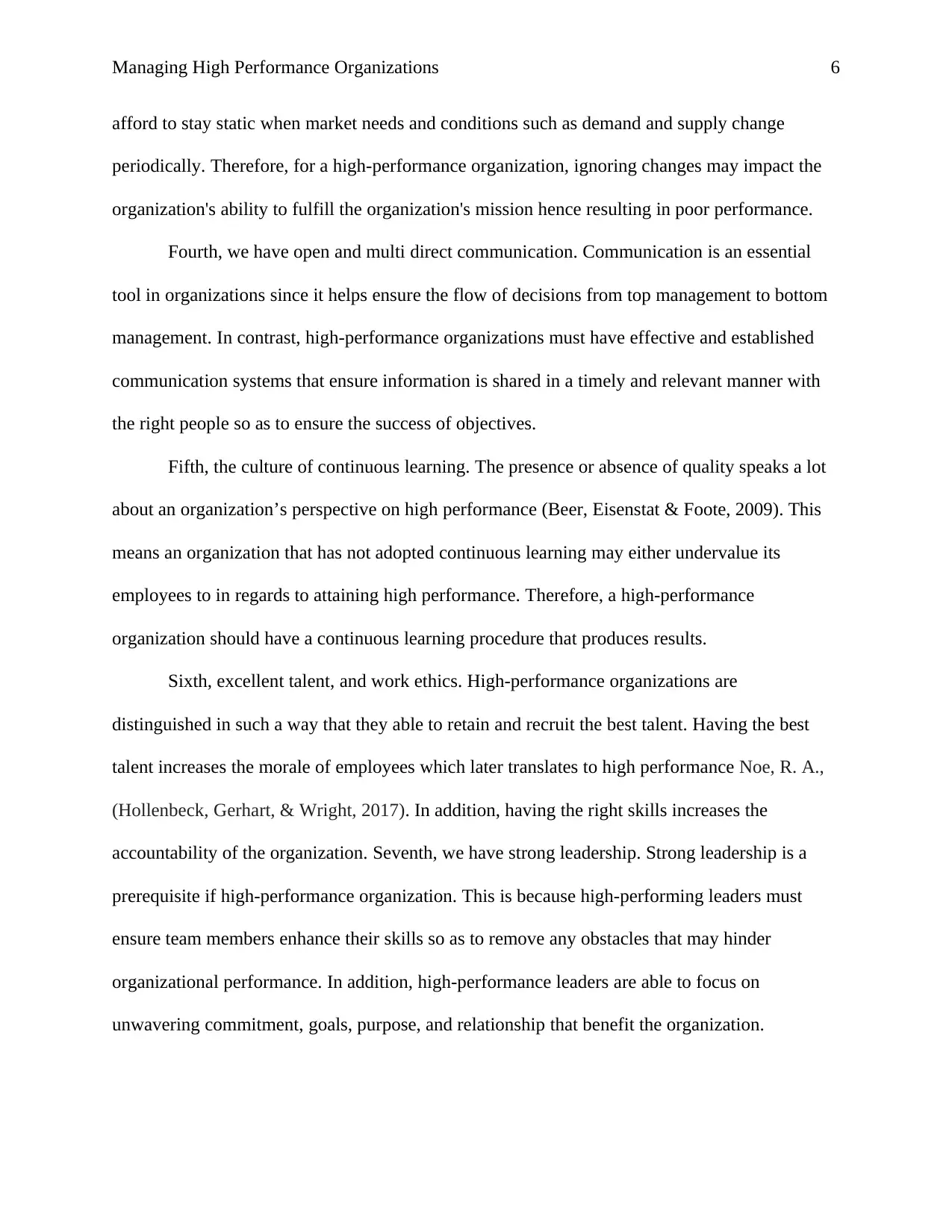
Managing High Performance Organizations 6
afford to stay static when market needs and conditions such as demand and supply change
periodically. Therefore, for a high-performance organization, ignoring changes may impact the
organization's ability to fulfill the organization's mission hence resulting in poor performance.
Fourth, we have open and multi direct communication. Communication is an essential
tool in organizations since it helps ensure the flow of decisions from top management to bottom
management. In contrast, high-performance organizations must have effective and established
communication systems that ensure information is shared in a timely and relevant manner with
the right people so as to ensure the success of objectives.
Fifth, the culture of continuous learning. The presence or absence of quality speaks a lot
about an organization’s perspective on high performance (Beer, Eisenstat & Foote, 2009). This
means an organization that has not adopted continuous learning may either undervalue its
employees to in regards to attaining high performance. Therefore, a high-performance
organization should have a continuous learning procedure that produces results.
Sixth, excellent talent, and work ethics. High-performance organizations are
distinguished in such a way that they able to retain and recruit the best talent. Having the best
talent increases the morale of employees which later translates to high performance Noe, R. A.,
(Hollenbeck, Gerhart, & Wright, 2017). In addition, having the right skills increases the
accountability of the organization. Seventh, we have strong leadership. Strong leadership is a
prerequisite if high-performance organization. This is because high-performing leaders must
ensure team members enhance their skills so as to remove any obstacles that may hinder
organizational performance. In addition, high-performance leaders are able to focus on
unwavering commitment, goals, purpose, and relationship that benefit the organization.
afford to stay static when market needs and conditions such as demand and supply change
periodically. Therefore, for a high-performance organization, ignoring changes may impact the
organization's ability to fulfill the organization's mission hence resulting in poor performance.
Fourth, we have open and multi direct communication. Communication is an essential
tool in organizations since it helps ensure the flow of decisions from top management to bottom
management. In contrast, high-performance organizations must have effective and established
communication systems that ensure information is shared in a timely and relevant manner with
the right people so as to ensure the success of objectives.
Fifth, the culture of continuous learning. The presence or absence of quality speaks a lot
about an organization’s perspective on high performance (Beer, Eisenstat & Foote, 2009). This
means an organization that has not adopted continuous learning may either undervalue its
employees to in regards to attaining high performance. Therefore, a high-performance
organization should have a continuous learning procedure that produces results.
Sixth, excellent talent, and work ethics. High-performance organizations are
distinguished in such a way that they able to retain and recruit the best talent. Having the best
talent increases the morale of employees which later translates to high performance Noe, R. A.,
(Hollenbeck, Gerhart, & Wright, 2017). In addition, having the right skills increases the
accountability of the organization. Seventh, we have strong leadership. Strong leadership is a
prerequisite if high-performance organization. This is because high-performing leaders must
ensure team members enhance their skills so as to remove any obstacles that may hinder
organizational performance. In addition, high-performance leaders are able to focus on
unwavering commitment, goals, purpose, and relationship that benefit the organization.
⊘ This is a preview!⊘
Do you want full access?
Subscribe today to unlock all pages.

Trusted by 1+ million students worldwide
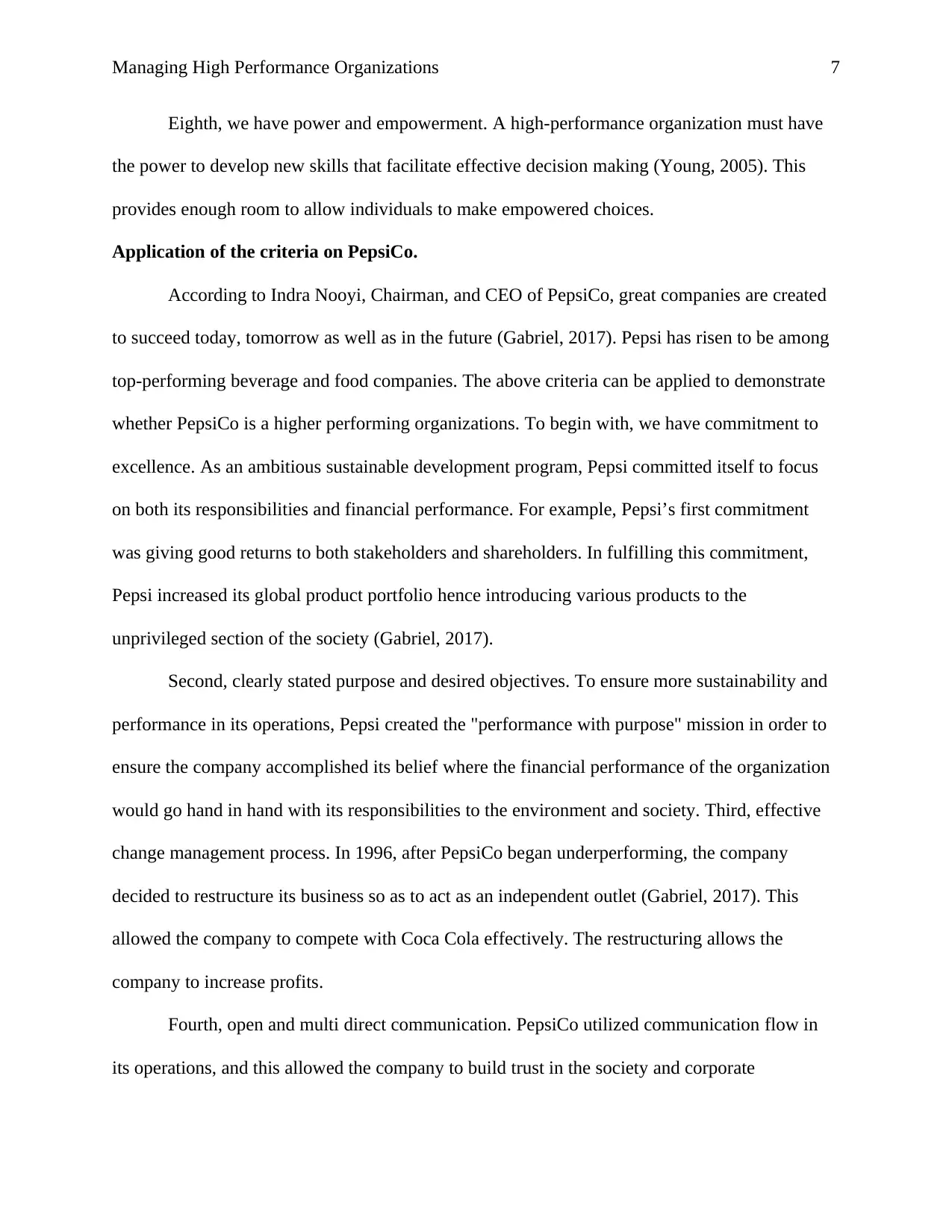
Managing High Performance Organizations 7
Eighth, we have power and empowerment. A high-performance organization must have
the power to develop new skills that facilitate effective decision making (Young, 2005). This
provides enough room to allow individuals to make empowered choices.
Application of the criteria on PepsiCo.
According to Indra Nooyi, Chairman, and CEO of PepsiCo, great companies are created
to succeed today, tomorrow as well as in the future (Gabriel, 2017). Pepsi has risen to be among
top-performing beverage and food companies. The above criteria can be applied to demonstrate
whether PepsiCo is a higher performing organizations. To begin with, we have commitment to
excellence. As an ambitious sustainable development program, Pepsi committed itself to focus
on both its responsibilities and financial performance. For example, Pepsi’s first commitment
was giving good returns to both stakeholders and shareholders. In fulfilling this commitment,
Pepsi increased its global product portfolio hence introducing various products to the
unprivileged section of the society (Gabriel, 2017).
Second, clearly stated purpose and desired objectives. To ensure more sustainability and
performance in its operations, Pepsi created the "performance with purpose" mission in order to
ensure the company accomplished its belief where the financial performance of the organization
would go hand in hand with its responsibilities to the environment and society. Third, effective
change management process. In 1996, after PepsiCo began underperforming, the company
decided to restructure its business so as to act as an independent outlet (Gabriel, 2017). This
allowed the company to compete with Coca Cola effectively. The restructuring allows the
company to increase profits.
Fourth, open and multi direct communication. PepsiCo utilized communication flow in
its operations, and this allowed the company to build trust in the society and corporate
Eighth, we have power and empowerment. A high-performance organization must have
the power to develop new skills that facilitate effective decision making (Young, 2005). This
provides enough room to allow individuals to make empowered choices.
Application of the criteria on PepsiCo.
According to Indra Nooyi, Chairman, and CEO of PepsiCo, great companies are created
to succeed today, tomorrow as well as in the future (Gabriel, 2017). Pepsi has risen to be among
top-performing beverage and food companies. The above criteria can be applied to demonstrate
whether PepsiCo is a higher performing organizations. To begin with, we have commitment to
excellence. As an ambitious sustainable development program, Pepsi committed itself to focus
on both its responsibilities and financial performance. For example, Pepsi’s first commitment
was giving good returns to both stakeholders and shareholders. In fulfilling this commitment,
Pepsi increased its global product portfolio hence introducing various products to the
unprivileged section of the society (Gabriel, 2017).
Second, clearly stated purpose and desired objectives. To ensure more sustainability and
performance in its operations, Pepsi created the "performance with purpose" mission in order to
ensure the company accomplished its belief where the financial performance of the organization
would go hand in hand with its responsibilities to the environment and society. Third, effective
change management process. In 1996, after PepsiCo began underperforming, the company
decided to restructure its business so as to act as an independent outlet (Gabriel, 2017). This
allowed the company to compete with Coca Cola effectively. The restructuring allows the
company to increase profits.
Fourth, open and multi direct communication. PepsiCo utilized communication flow in
its operations, and this allowed the company to build trust in the society and corporate
Paraphrase This Document
Need a fresh take? Get an instant paraphrase of this document with our AI Paraphraser
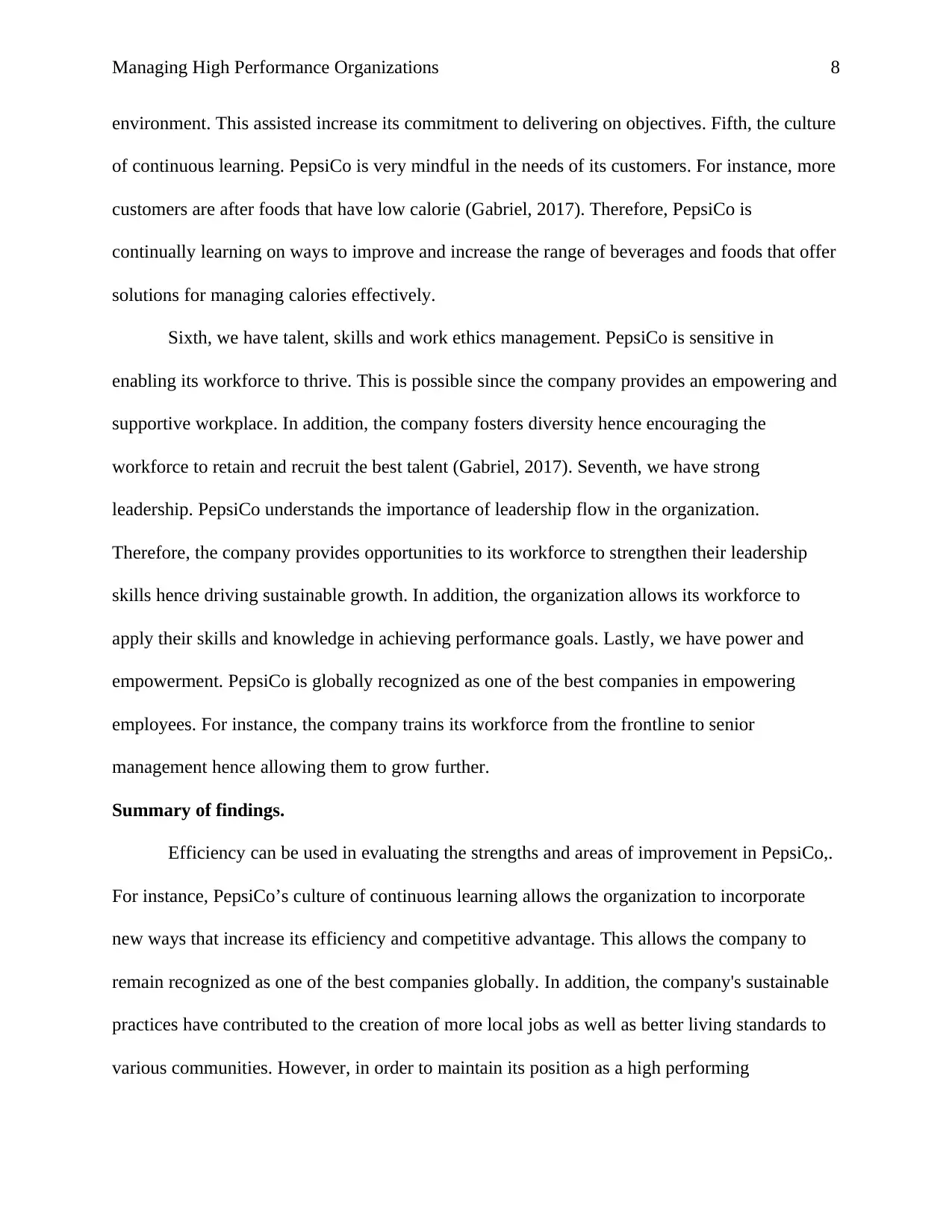
Managing High Performance Organizations 8
environment. This assisted increase its commitment to delivering on objectives. Fifth, the culture
of continuous learning. PepsiCo is very mindful in the needs of its customers. For instance, more
customers are after foods that have low calorie (Gabriel, 2017). Therefore, PepsiCo is
continually learning on ways to improve and increase the range of beverages and foods that offer
solutions for managing calories effectively.
Sixth, we have talent, skills and work ethics management. PepsiCo is sensitive in
enabling its workforce to thrive. This is possible since the company provides an empowering and
supportive workplace. In addition, the company fosters diversity hence encouraging the
workforce to retain and recruit the best talent (Gabriel, 2017). Seventh, we have strong
leadership. PepsiCo understands the importance of leadership flow in the organization.
Therefore, the company provides opportunities to its workforce to strengthen their leadership
skills hence driving sustainable growth. In addition, the organization allows its workforce to
apply their skills and knowledge in achieving performance goals. Lastly, we have power and
empowerment. PepsiCo is globally recognized as one of the best companies in empowering
employees. For instance, the company trains its workforce from the frontline to senior
management hence allowing them to grow further.
Summary of findings.
Efficiency can be used in evaluating the strengths and areas of improvement in PepsiCo,.
For instance, PepsiCo’s culture of continuous learning allows the organization to incorporate
new ways that increase its efficiency and competitive advantage. This allows the company to
remain recognized as one of the best companies globally. In addition, the company's sustainable
practices have contributed to the creation of more local jobs as well as better living standards to
various communities. However, in order to maintain its position as a high performing
environment. This assisted increase its commitment to delivering on objectives. Fifth, the culture
of continuous learning. PepsiCo is very mindful in the needs of its customers. For instance, more
customers are after foods that have low calorie (Gabriel, 2017). Therefore, PepsiCo is
continually learning on ways to improve and increase the range of beverages and foods that offer
solutions for managing calories effectively.
Sixth, we have talent, skills and work ethics management. PepsiCo is sensitive in
enabling its workforce to thrive. This is possible since the company provides an empowering and
supportive workplace. In addition, the company fosters diversity hence encouraging the
workforce to retain and recruit the best talent (Gabriel, 2017). Seventh, we have strong
leadership. PepsiCo understands the importance of leadership flow in the organization.
Therefore, the company provides opportunities to its workforce to strengthen their leadership
skills hence driving sustainable growth. In addition, the organization allows its workforce to
apply their skills and knowledge in achieving performance goals. Lastly, we have power and
empowerment. PepsiCo is globally recognized as one of the best companies in empowering
employees. For instance, the company trains its workforce from the frontline to senior
management hence allowing them to grow further.
Summary of findings.
Efficiency can be used in evaluating the strengths and areas of improvement in PepsiCo,.
For instance, PepsiCo’s culture of continuous learning allows the organization to incorporate
new ways that increase its efficiency and competitive advantage. This allows the company to
remain recognized as one of the best companies globally. In addition, the company's sustainable
practices have contributed to the creation of more local jobs as well as better living standards to
various communities. However, in order to maintain its position as a high performing

Managing High Performance Organizations 9
organization, PepsiCo may have to increase its commitment to excellence hence becoming more
efficient. Coke is a fierce competitor, and therefore, PepsiCo may consider focusing more on
excellence so as to increase its market share
organization, PepsiCo may have to increase its commitment to excellence hence becoming more
efficient. Coke is a fierce competitor, and therefore, PepsiCo may consider focusing more on
excellence so as to increase its market share
⊘ This is a preview!⊘
Do you want full access?
Subscribe today to unlock all pages.

Trusted by 1+ million students worldwide
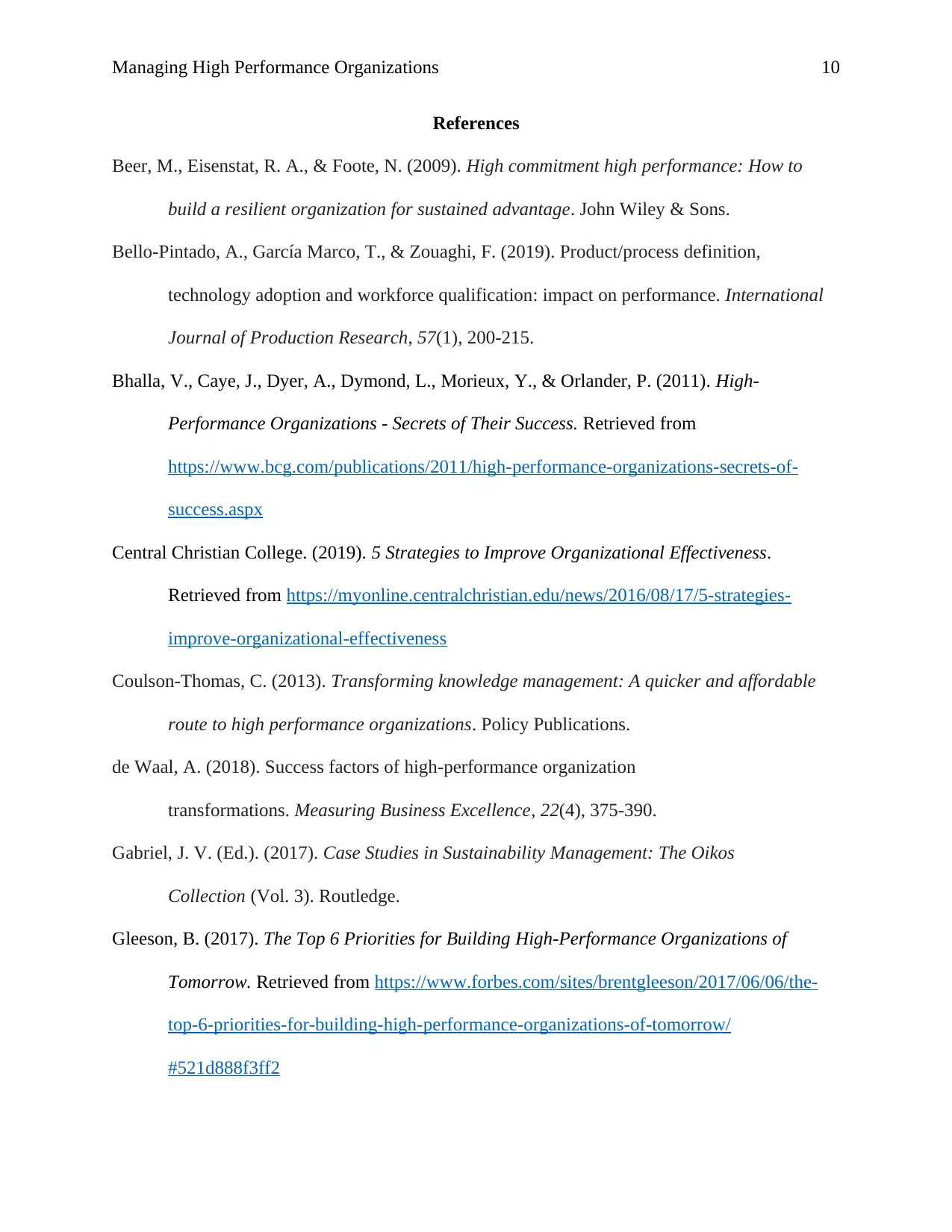
Managing High Performance Organizations 10
References
Beer, M., Eisenstat, R. A., & Foote, N. (2009). High commitment high performance: How to
build a resilient organization for sustained advantage. John Wiley & Sons.
Bello-Pintado, A., García Marco, T., & Zouaghi, F. (2019). Product/process definition,
technology adoption and workforce qualification: impact on performance. International
Journal of Production Research, 57(1), 200-215.
Bhalla, V., Caye, J., Dyer, A., Dymond, L., Morieux, Y., & Orlander, P. (2011). High-
Performance Organizations - Secrets of Their Success. Retrieved from
https://www.bcg.com/publications/2011/high-performance-organizations-secrets-of-
success.aspx
Central Christian College. (2019). 5 Strategies to Improve Organizational Effectiveness.
Retrieved from https://myonline.centralchristian.edu/news/2016/08/17/5-strategies-
improve-organizational-effectiveness
Coulson-Thomas, C. (2013). Transforming knowledge management: A quicker and affordable
route to high performance organizations. Policy Publications.
de Waal, A. (2018). Success factors of high-performance organization
transformations. Measuring Business Excellence, 22(4), 375-390.
Gabriel, J. V. (Ed.). (2017). Case Studies in Sustainability Management: The Oikos
Collection (Vol. 3). Routledge.
Gleeson, B. (2017). The Top 6 Priorities for Building High-Performance Organizations of
Tomorrow. Retrieved from https://www.forbes.com/sites/brentgleeson/2017/06/06/the-
top-6-priorities-for-building-high-performance-organizations-of-tomorrow/
#521d888f3ff2
References
Beer, M., Eisenstat, R. A., & Foote, N. (2009). High commitment high performance: How to
build a resilient organization for sustained advantage. John Wiley & Sons.
Bello-Pintado, A., García Marco, T., & Zouaghi, F. (2019). Product/process definition,
technology adoption and workforce qualification: impact on performance. International
Journal of Production Research, 57(1), 200-215.
Bhalla, V., Caye, J., Dyer, A., Dymond, L., Morieux, Y., & Orlander, P. (2011). High-
Performance Organizations - Secrets of Their Success. Retrieved from
https://www.bcg.com/publications/2011/high-performance-organizations-secrets-of-
success.aspx
Central Christian College. (2019). 5 Strategies to Improve Organizational Effectiveness.
Retrieved from https://myonline.centralchristian.edu/news/2016/08/17/5-strategies-
improve-organizational-effectiveness
Coulson-Thomas, C. (2013). Transforming knowledge management: A quicker and affordable
route to high performance organizations. Policy Publications.
de Waal, A. (2018). Success factors of high-performance organization
transformations. Measuring Business Excellence, 22(4), 375-390.
Gabriel, J. V. (Ed.). (2017). Case Studies in Sustainability Management: The Oikos
Collection (Vol. 3). Routledge.
Gleeson, B. (2017). The Top 6 Priorities for Building High-Performance Organizations of
Tomorrow. Retrieved from https://www.forbes.com/sites/brentgleeson/2017/06/06/the-
top-6-priorities-for-building-high-performance-organizations-of-tomorrow/
#521d888f3ff2
Paraphrase This Document
Need a fresh take? Get an instant paraphrase of this document with our AI Paraphraser
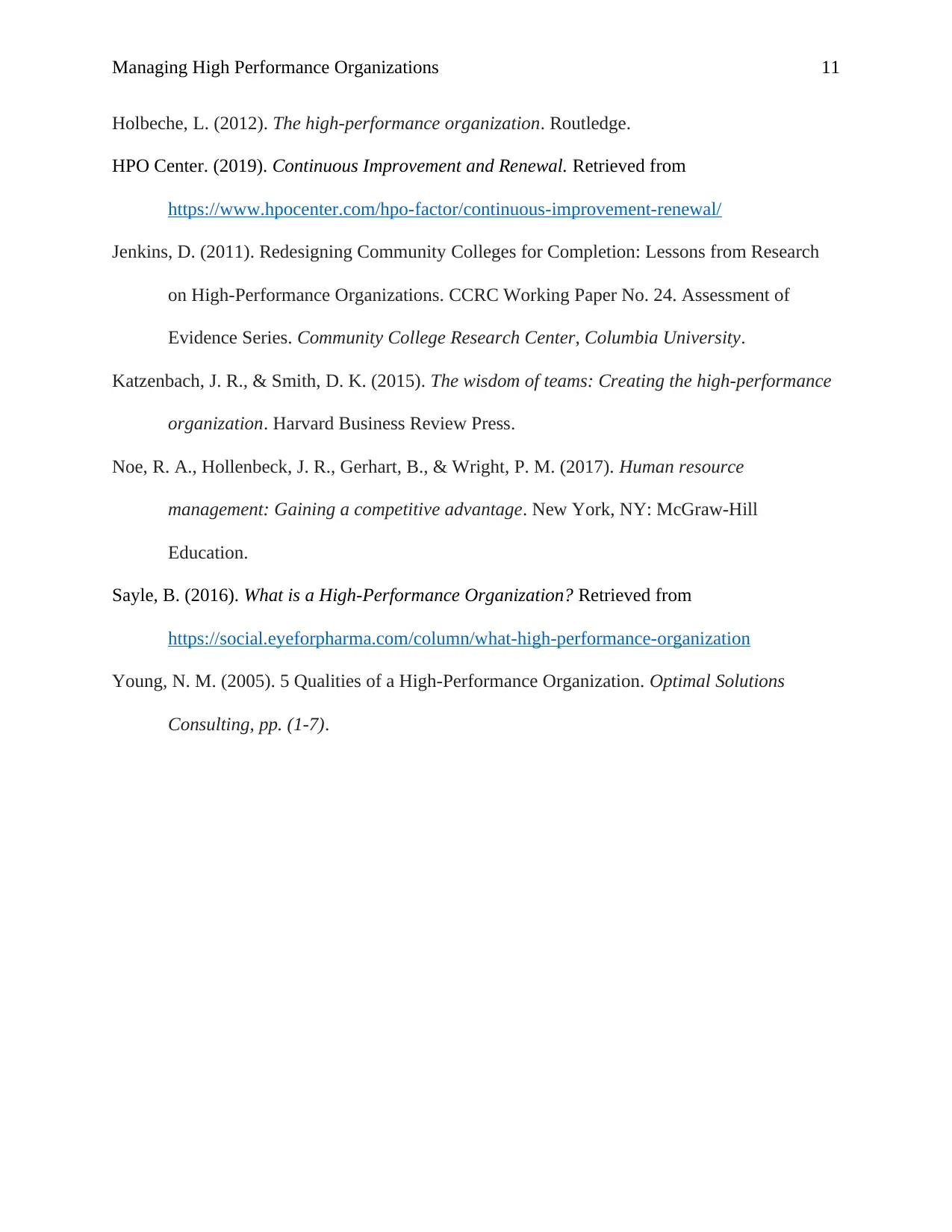
Managing High Performance Organizations 11
Holbeche, L. (2012). The high-performance organization. Routledge.
HPO Center. (2019). Continuous Improvement and Renewal. Retrieved from
https://www.hpocenter.com/hpo-factor/continuous-improvement-renewal/
Jenkins, D. (2011). Redesigning Community Colleges for Completion: Lessons from Research
on High-Performance Organizations. CCRC Working Paper No. 24. Assessment of
Evidence Series. Community College Research Center, Columbia University.
Katzenbach, J. R., & Smith, D. K. (2015). The wisdom of teams: Creating the high-performance
organization. Harvard Business Review Press.
Noe, R. A., Hollenbeck, J. R., Gerhart, B., & Wright, P. M. (2017). Human resource
management: Gaining a competitive advantage. New York, NY: McGraw-Hill
Education.
Sayle, B. (2016). What is a High-Performance Organization? Retrieved from
https://social.eyeforpharma.com/column/what-high-performance-organization
Young, N. M. (2005). 5 Qualities of a High-Performance Organization. Optimal Solutions
Consulting, pp. (1-7).
Holbeche, L. (2012). The high-performance organization. Routledge.
HPO Center. (2019). Continuous Improvement and Renewal. Retrieved from
https://www.hpocenter.com/hpo-factor/continuous-improvement-renewal/
Jenkins, D. (2011). Redesigning Community Colleges for Completion: Lessons from Research
on High-Performance Organizations. CCRC Working Paper No. 24. Assessment of
Evidence Series. Community College Research Center, Columbia University.
Katzenbach, J. R., & Smith, D. K. (2015). The wisdom of teams: Creating the high-performance
organization. Harvard Business Review Press.
Noe, R. A., Hollenbeck, J. R., Gerhart, B., & Wright, P. M. (2017). Human resource
management: Gaining a competitive advantage. New York, NY: McGraw-Hill
Education.
Sayle, B. (2016). What is a High-Performance Organization? Retrieved from
https://social.eyeforpharma.com/column/what-high-performance-organization
Young, N. M. (2005). 5 Qualities of a High-Performance Organization. Optimal Solutions
Consulting, pp. (1-7).
1 out of 11
Related Documents
Your All-in-One AI-Powered Toolkit for Academic Success.
+13062052269
info@desklib.com
Available 24*7 on WhatsApp / Email
![[object Object]](/_next/static/media/star-bottom.7253800d.svg)
Unlock your academic potential
Copyright © 2020–2025 A2Z Services. All Rights Reserved. Developed and managed by ZUCOL.





